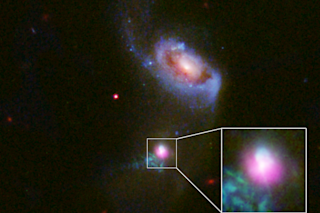The galaxy SDSS J1354+1327 (just below the center of the image) hosts a supermassive black hole that has let out two "burps" in the past 100,000 years. The older burp can be seen to the lower left of the galaxy as a diffuse, blue-green glow. The more recent burp appears as a bright blue-white arc to the upper left of the galaxy's center. Its companion galaxy, SDSS J1354+1328, lies just above the center of the image. (Credit: NASA , ESA, and J. Comerford/University of Colorado-Boulder) Supermassive black holes reside at the center of most, if not all, massive (and possibly low-mass) galaxies. They range in size from millions to billions of solar masses, and they can eat voraciously or not at all, depending on their surroundings. But one thing is clear: Black holes don’t have very good table manners, as a team led by researchers at the University of Colorado ...
A Black Hole 'Double Burps'
Explore the fascinating discoveries of the supermassive black hole in galaxy SDSS J1354+1327 and its burps of energy.
More on Discover
Stay Curious
SubscribeTo The Magazine
Save up to 40% off the cover price when you subscribe to Discover magazine.
Subscribe













